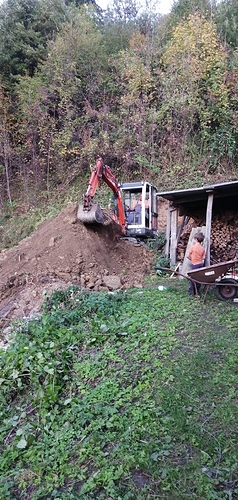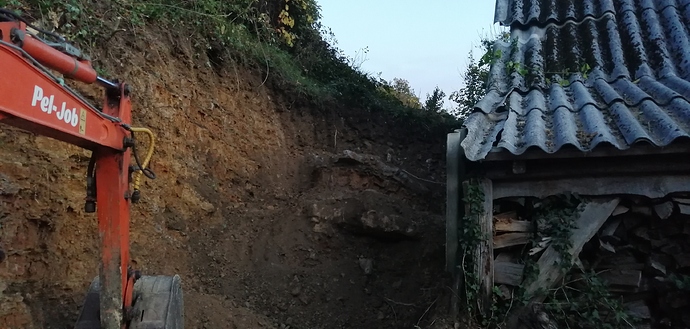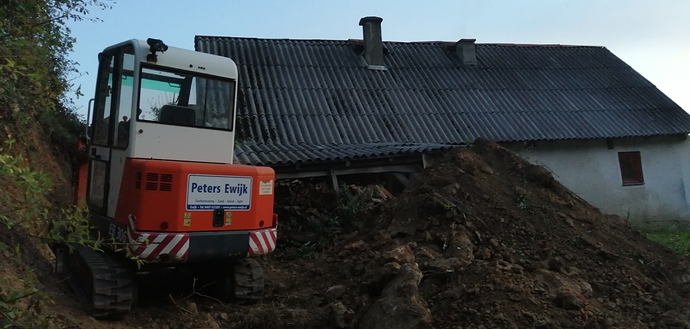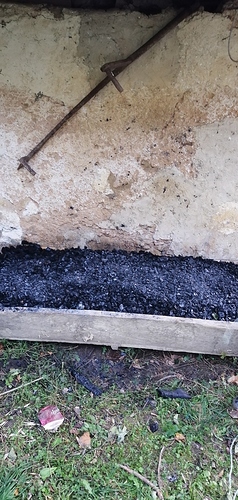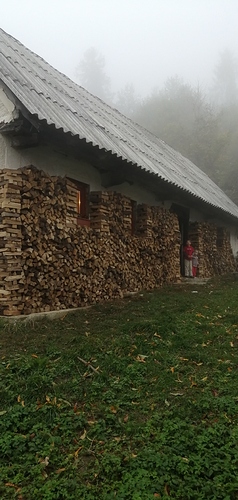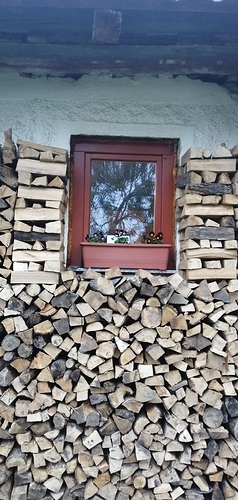Nice pics, Kristijan! Magnificent view.
Your wood burning cooking stove looks brand new. You do the right thing keeping it. A kitchen is no kitchen without one.
Also, windows, wall grout and the concrete floor looks new. Did you manage to redo them right away?
Steve, ha! And a oven!
True. Funny, this stove is exactly the same model l have had at home, only miror image. We cook on it all the time exept in July and August, it wuld get too hot inside. I am used to it wery well, or at least so l thod. Did the same steps as l do at home and l burned the first bread loaf  its interasting how a identical machine can act so differently, different wood and chimney… thats what l like with wood burnin stoves. Personality.
its interasting how a identical machine can act so differently, different wood and chimney… thats what l like with wood burnin stoves. Personality.
Windows are brand new, double glass. Everything else is old and in poor shape. The floor was poured in not long ago, before it was just dirth and wood floor, still is on the other half of the house. Unfortunaly the concrete is poured poorly and will need to be beeten out, and redone.
The walls are 2 feet thick and made of stone and clay/lime malter. That will require extensive repair allso. It served for over 200 years but now its run its corse, lineing is peeling off severely.
Flames rise and go horisontal between hob and oven top, right?
You probably already know, but on top of the oven is usually a layer of clay with iron shavings mixed in. Just to give the right amount of heat transfer. Check if that layer is still intact.
You sure picked the nicest place. The house looks nice and solid.
Ha, its more complicated. You have two options. Either direct the gasflow horisontaly over the top of the oven and in the chimney, or with a hach direct the gas to go over the top, then down, around and under the oven, then back up and out. Its a good design and with some practice you can set is better thain any electric oven.
No, this model only has firebrick in the burning part. The oven is just metal, in a few layers. but l like to leave some ash on top to act as a heat biffer. Perhaps this is the reason for the bread to burn, since it was swept clean.
Same path as mine, which is maybe 100 years old. I don’t have the by-pass option though.
Ha, I was going to mention I never got to replacing my clay and that I leave a layer of ash instead 
The bypass option is wery usefull. Faster startup when chimney is cold, and higher power output on the cooking top. And, its great for those final touches on the Sunday roast, if the bypass and air are both open the oven top will get extremely hot, even glowing a dull red sometimes, thats great for making a crunchy chrust 
The machinery rolled in
One side of the house was burryed and woth no hydroinsulation the stone wall was always damp. We are correcting that plus we gain acess to the other side of the house wich was only possible on foot before.
A neighbour offerd to help me out, but it was a hard job. The whole part was layrs of stone of various hardnesses. Some will need to be blasted carefully.
And this is the outcome of the burn!
Thats about 60 pounds of charcoal, worth nearly 50$ in petrol. Not bad for burning some junk 
I realy like this charcoal maker pit. I got the inspiration from Dons cone kiln. It works great but the problem is its made of dirth and some crumbles and mixes with char. Has anyone got a idea what l culd line it with to prevent thos?
I would aim to use sheet metal made into a cone shape. It should last a fair while even if thin, as the heat will be going up. As long as it keeps dirt out of the charcoal.
I like using a long trough type kiln above ground, long is good for branches, wider is good too. A lot of char can be made from small branches, they char much more efficiently too.
Kristijan, you certainly have steep terrain. I would worry that wall of dirt would cave in.
I see you’re using charcoal for a sill barrier. A good idea. Many old houses, with not enough room under the floor insulation for good ventilation, have packed charcoal on the ground. It kept things dry for hundereds of years.
If you’re serious about knocking out the old concrete floor and replace it I would suggest making room for insulation towards the ground. Wind and tie down a pattern of plastic hose to the rebar screen too, for future floor heating. You won’t regret the extra effort. The concret is usually poured on top of a 20-30 cm layer of cell foam, but I know some use a bed of leca. Maybe even charcoal could do the job. I guess you already studied your options.
Garry, l will try finding something that big. Not planing to spend much money on it 
JO, l will make a closeup but the dirth isnt dirth at all. Its crumbly rock with 5" layrs of realy tough rock. But l am planing to make a retaining wall to prevent crumbleing, and l might concider burrowing in the wall for a root cellar.
Ha, that is just a wooden box l poured motor fuel in. But your idea is interasting! I guess charcoal isnt good at wicking water?
Well l certainly will concider winding hoses trugh concrete, specialy in the bathroom. In the kichen/living room there will be enough heat from the wood stove wich burns 24/7 in times from September to June, and the bedrooms in the attic will likely have wooden floors wich dont go well with floor heating, so l have to figure out a dofferent solution. I was thinking to building ventilation shafts in walls and floors for warm air to pass from the hot water boiler in the boiler room. Maybee have air channels built in the hot water tank. Has anyone done something like this?
What is leca?
Ha, l am studying as l go  they say here you make your third house perfect. I am not doing that many so the opinion and advice of you guys with more experiancea means a lot to me.
they say here you make your third house perfect. I am not doing that many so the opinion and advice of you guys with more experiancea means a lot to me.
Maybe do not harvest the charcoal all the way down. Take out $45 worth instead of $50.
My wife sugested that. Problem is the dirth crumbles from the sides.
Kristijan, if you have any plans for a dividing wall or a row of cabinets or something like that building in a hollow chase cavity is a great way to move services around in older homes. I love my radiant in the slab but how well it works depends on the original structure. Houses that are too drafty don’t do as well on radiant as well insulated buildings because the warmth moves slowly. Insulating the slab though is a great plan. Is the plan to leave that back wall exposed and put in a retaining wall or to refill it when the work is done? I would be concerned about frost now having access to the bottom of the wall and floor system. If so a 50mm layer of closed cell foam 60-120 cms out from the perimeter would be a good plan. Also a 60-120cm foam layer against the stone is a great idea with all the expensive digging done if the plan is to backfill. The heat loss to stone walls is huge and since modern homes are usually heated unlike in the past it can cause all sorts of condensation and mold issues. I’m sure all this is known to you but its mostly for the conversation.
watching closely with a fair bit of envy…
Cheers, David
“Light expanded clay aggregate, *LECA”
It’s like pop-corn. Light marbles of dried puffed up clay. Pretty much like cell foam but made of clay rather then plastic, which is good from an enviromental standpoint. Most prefab sills are made of reinforced leca nowdays. Different sized bricks too. At least up here traditional red bricks and cell foam are becoming more expensive than leca based building material.
Comes in bulk too. Pretty much like lightweight insulative gravel.
Kristijan, what did you cover the fire with so the char doesn’t go to ash? TomC
I suggest you try lining your pit with a mixture of clay and sand. The heat will then fire the top surface into a pretty resilient ceramic. Not sure if you have sand on your property there, but you need to add quite a bit to the clay so it doesnt shrink too much - maybe 2:1 or 3:1 with clay. I make test bricks and mark off 2 lines 10" apart, then measure how much the whole thing shrinks as it dries. You want to try and keep it under 5%. It will lose another couple percent when fired. Cracks are inevitable, but you can just cram more clay into the really big ones.
The logs of small size testify that you master well the combustion.
You’re having way too much fun Kristijan 
Hi Kristijan , i have also made charcoal from a dirt pit at certain times when i have a lot of fallen tree waste , and i have a percentage of clay getting into the charcoal , but once its crushed and screened most of it is small enough to pass through with the fines , only a few stubborn well baked bits that i tend to see and pull out .
keep an eye out for a old 3pl seed spreader or muck spreader cone , thats what i use these days and its easy to shovel out the charcoal into sealed drums once its lost all the flames .
Dave
